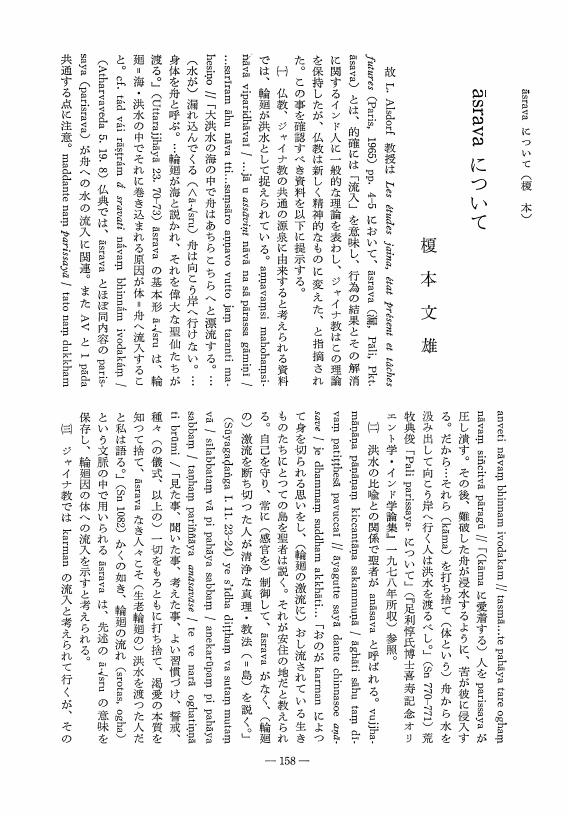3 0 0 0 中世真言僧における宋代翻訳経軌の受容
<p>中国における仏典翻訳事業は,9世紀半ばに一度途絶するが,それからおよそ160年後,当時中国を治めていた宋の皇帝,太祖,太宗,あるいは真宗の手厚い援助により再興する.彼らは,当時の都に訳経院と呼ばれる施設を作り,そこに数多の梵文仏典を集積し,法天(Dharmadeva),天息災(Devaśāntika),施護(Dānapāla)といった僧をして,その翻訳にあたらせた.法天らは,11世紀半ばまでに263部573巻の仏典を翻訳したと伝えられるが,武内孝善氏によると,その47パーセント,123部は密教関連の経典ないし儀軌であった.また,それら翻訳された密教経軌の中には,『ヘーヴァジュラタントラ』や『秘密集会タントラ』といった,いわゆる後期密教に属するものも少なからず含まれていた.</p><p>先行研究でも指摘されるように,非常に多くの,極めてバラエティに富む密教経軌が,10世紀から11世紀にかけて一時に漢訳された.それらは中国のみならず,韓国や日本の仏教者にもひろく閲読されたと思われるが,本論では,これら宋代に翻訳された密教経軌の日本における受容について考察する.特に,真言密教僧がそれら経軌をどのように読み,また,いかなる影響を被ったか考えてみたい.</p><p>真言僧が,宋代翻訳経軌をいかに受容したかという問題については,既に千葉正氏が論考を試みている.千葉氏は,鎌倉・室町時代を代表する東寺の学僧,杲宝の『アキシャ鈔』『秘蔵要文集』といった著作を検討し,それら文献中の教学議論において,施護あるいは天息災訳の密教経軌が,極めて重要な役割を担っていることを指摘する.筆者も,このような千葉氏の方法論にならい,杲宝の主要著作の一つである『大日経疏演奥鈔』に確認される宋代翻訳経軌の引用および解釈を検討し,上述の問題について考察を試みる.</p>
3 0 0 0 OA 愚管抄における叡山仏教
- 著者
- 渡辺 守順
- 出版者
- JAPANESE ASSOCIATION OF INDIAN AND BUDDHIST STUDIES
- 雑誌
- 印度學佛教學研究 (ISSN:00194344)
- 巻号頁・発行日
- vol.26, no.2, pp.753-756, 1978-03-20 (Released:2010-03-09)
- 参考文献数
- 8
3 0 0 0 OA 古典劇「土の小車」の著者シュードラカについて
- 著者
- 岩本 裕
- 出版者
- JAPANESE ASSOCIATION OF INDIAN AND BUDDHIST STUDIES
- 雑誌
- 印度學佛教學研究 (ISSN:00194344)
- 巻号頁・発行日
- vol.3, no.2, pp.448-451, 1955-03-30 (Released:2010-03-09)
3 0 0 0 OA 中世禅宗の土地伽藍神について
- 著者
- 広瀬 良文
- 出版者
- 日本印度学仏教学会
- 雑誌
- 印度學佛教學研究 (ISSN:00194344)
- 巻号頁・発行日
- vol.62, no.2, pp.723-726, 2014-03-20 (Released:2017-09-01)
3 0 0 0 シャンバラ国について
- 著者
- 西岡 祖秀
- 出版者
- JAPANESE ASSOCIATION OF INDIAN AND BUDDHIST STUDIES
- 雑誌
- 印度學佛教學研究 (ISSN:00194344)
- 巻号頁・発行日
- vol.55, no.1, pp.474-468,1230, 2006
The Country of Shambhala is an ideal Buddhist kingdom described in the <i>Kalacatantra</i>. The 25<sup>th</sup> generation Raudracakrin king of this country is said to win the final war with Islam, and revive Buddhism. When the <i>Kalacakratantra</i> was introduced to Tibet after the 11th century, it was widely accepted by Tibetan Buddhists. 'Jam-dbyangs-bzhad-pa (1648-1722) and Sumpa-mkhan-po (1704-1788), who were great scholars of the dGe lugs sect in the 18th century, wrote Chronological Tables of Tibetan Buddhism. The enthronement of the king of Shambhala is stated in both chronological tables, and the revival of Buddhism by the Raudracakrin king is predicted. This paper provides a general description of the Country of Shambhala from the <i>Dang po'i rgyas dpal dus kyi 'khor lo'i lo rgyus dang ming gi rnam grangs</i> of Klong-rdol-bla-ma (1719-1805), who was a great scholar of the dGe lugs sect.
3 0 0 0 OA 後期グプタ朝の分裂について
- 著者
- 山田 明爾
- 出版者
- JAPANESE ASSOCIATION OF INDIAN AND BUDDHIST STUDIES
- 雑誌
- 印度學佛教學研究 (ISSN:00194344)
- 巻号頁・発行日
- vol.12, no.2, pp.620-627, 1964-03-31 (Released:2010-03-09)
3 0 0 0 OA 『正法華経』薬王如来品と『維摩経』法供養品について
- 著者
- 河野 訓
- 出版者
- JAPANESE ASSOCIATION OF INDIAN AND BUDDHIST STUDIES
- 雑誌
- 印度學佛教學研究 (ISSN:00194344)
- 巻号頁・発行日
- vol.46, no.1, pp.242-246, 1997-12-20 (Released:2010-03-09)
3 0 0 0 OA 『小空経』における空の実践構造について
- 著者
- 井上 ウィマラ
- 出版者
- 日本印度学仏教学会
- 雑誌
- 印度學佛教學研究 (ISSN:00194344)
- 巻号頁・発行日
- vol.58, no.2, pp.916-911, 2010-03-20
3 0 0 0 OA 悪人正機説の系譜について
- 著者
- 梶村 昇
- 出版者
- JAPANESE ASSOCIATION OF INDIAN AND BUDDHIST STUDIES
- 雑誌
- 印度學佛教學研究 (ISSN:00194344)
- 巻号頁・発行日
- vol.19, no.1, pp.348-353, 1970-12-25 (Released:2010-03-09)
3 0 0 0 世親淨土論に於ける十地經的要素
- 著者
- 長谷岡 一也
- 出版者
- JAPANESE ASSOCIATION OF INDIAN AND BUDDHIST STUDIES
- 雑誌
- 印度學佛教學研究 (ISSN:00194344)
- 巻号頁・発行日
- vol.6, no.2, pp.493-496, 1958
3 0 0 0 OA シャンカラにおける瞑想の一側面
- 著者
- 村上 幸三
- 出版者
- 日本印度学仏教学会
- 雑誌
- 印度學佛教學研究 (ISSN:00194344)
- 巻号頁・発行日
- vol.39, no.2, pp.964-962, 1991-03-20 (Released:2010-03-09)
3 0 0 0 OA 佛教心理學の成立と課題
- 著者
- 西光 義敞
- 出版者
- JAPANESE ASSOCIATION OF INDIAN AND BUDDHIST STUDIES
- 雑誌
- 印度學佛教學研究 (ISSN:00194344)
- 巻号頁・発行日
- vol.6, no.2, pp.461-464, 1958-03-30 (Released:2010-03-09)
3 0 0 0 OA naksatra-「月宿」の成立 : ヴェーダ暦と祭式・儀礼
- 著者
- 阪本(後藤) 純子
- 出版者
- 日本印度学仏教学会
- 雑誌
- 印度學佛教學研究 (ISSN:00194344)
- 巻号頁・発行日
- vol.59, no.3, pp.1075-1083, 2011-03-25
ヴェーダ文献(紀元前1200-500年頃)に残る太陰太陽暦では,月の形態および月と白道近辺の恒星の位置関係により月日が決定される.祭式の日時を決定するために月の朔望と運動が注意深く観察され,naksatra-「月宿」の概念が成立する.月は朔から朔の間(1朔望月:約29.53日),白道近辺にほぼ等間隔に位置する恒星(群)に順次近づき,朔の夜(amavasya-)には太陽と合一して姿を消す.これらの恒星(群)(RVでは太陽を含む)はnaksatra-「(月が)到達する所」「月宿」と呼ばれ,月と恒星との位置関係を示す指標となる.krttikas(Pleiades昴)を起点とするこれらの恒星(群)は,ヨーロッパ青銅器時代の考古学遺品(Nebra Sky Disk)が示唆するように,ヴェーダ期を遙かに遡る古代に起源を持つ可能性がある.Naksatra崇拝や婚姻・戦闘等のために吉祥なNaksatraを選ぶ風習は,光(太陽・火)を崇め闇・夜を避ける傾向の強いヴェーダ祭式よりも,むしろ民間儀礼において発達し,部分的にシュラウタ祭式に取り入れられた形跡が伺える.Naksatraの列挙はAtharvaveda XIX 7,Yajurveda-Samhitaマントラ(Agnicayana火壇第五層のNaksatra煉瓦:Maitrayani Samhita II 13,20,Kathaka-Samhita XXXIX 13,Taittiriya-Samhita IV 4,10),Taittiriya-Brahmanaマントラ(15,1:Naksatra祭?),マントラと散文(III 1:Naksatra献供)に見られ,さらに部分的にTB散文(I 5,2-3:Naksatra解説)にも残るが,いずれも後代の補遺部分とみなされる.これらのNaksatraの列挙は,朔望月に基づく28 Naksatra方式と恒星月に基づく27 Naksatra方式に分類されるが,前者は月と恒星の位置を正確に反映せず,後者は朔望月の日付と対応しない.この矛盾を解決するために,上記Agnicayanaのマントラおよびシュラウタ・スートラでは,本来は次元の異なる概念である満月・朔の夜を27 Naksatraに付け加えるなどの工夫が試みられる.より平易な28方式は一般大衆の民間儀礼に好まれ,より正確な27方式は祭官学者間に普及したことが上記文献から推測される.(後者はJyotisa以降の天文学において黄道の均等な27区分に変質する.)
3 0 0 0 OA サンスクリット文學に於ける HAMSA について
- 著者
- 長柄 行光
- 出版者
- JAPANESE ASSOCIATION OF INDIAN AND BUDDHIST STUDIES
- 雑誌
- 印度學佛教學研究 (ISSN:00194344)
- 巻号頁・発行日
- vol.17, no.2, pp.609-614, 1969-03-31 (Released:2010-03-09)
3 0 0 0 OA 現代に於ける殉教思想 -ある日本人僧侶の殉教を通して-
- 著者
- 笹森 行周
- 出版者
- JAPANESE ASSOCIATION OF INDIAN AND BUDDHIST STUDIES
- 雑誌
- 印度學佛教學研究 (ISSN:00194344)
- 巻号頁・発行日
- vol.55, no.2, pp.1028-1025,1291, 2007-03-20 (Released:2010-07-01)
Rev. Yokotsuka (1952-1984) was a disciple of the Most Ven. Nichidatsu Fujii, founder of Nipponzan Myohoji Buddhist Order in Japan. In Sri Lanka for 6 years he had been praying to bring about peace among peoples there.However he was shot dead on the street in Jaffna on 28 Oct. 1984 at the age of 32, while he was bowing to show veneration to the men who were going to assassinate him. This practice of bowing, through the veneration and worship of the Buddha-nature existing in all beings, is based on the practice by the Never Despising Bodhisattva in Chapter 20 of the Lotus Sutra.Rev. Yokotsuka's martyrdom was nothing more than an encounter between violence and the practice of Bowing, the supreme way of non-violence which in Japan was first practiced and embodied by the 13th. century's great monk Nichiren (1222-1282).Rev. Yokotsuka showed us some ideas of the Bodhisattva's vows taken by Mahayana Buddhist who see no enemies around them, believing that everyone is to become a Buddha. The practitioners find their places of mission voluntarily amongst real troubles. They practice the Bodhisattva's vows without the fear that they will be misunderstood, ridiculed, or beaten to death. This is the significance of Martyrdom in the present-day.
3 0 0 0 OA パタムパ・サンゲの遺誡について
- 著者
- 西岡 祖秀
- 出版者
- 日本印度学仏教学会
- 雑誌
- 印度學佛教學研究 (ISSN:00194344)
- 巻号頁・発行日
- vol.58, no.1, pp.483-476, 2009-12-20
3 0 0 0 OA 普遍の觀念を手がかりとするヴァイシェーシカ體系の考察
- 著者
- 中村 元
- 出版者
- JAPANESE ASSOCIATION OF INDIAN AND BUDDHIST STUDIES
- 雑誌
- 印度學佛教學研究 (ISSN:00194344)
- 巻号頁・発行日
- vol.7, no.2, pp.695-708, 1959-03-30 (Released:2010-03-09)
3 0 0 0 OA asrava について
- 著者
- 榎本 文雄
- 出版者
- JAPANESE ASSOCIATION OF INDIAN AND BUDDHIST STUDIES
- 雑誌
- 印度學佛教學研究 (ISSN:00194344)
- 巻号頁・発行日
- vol.27, no.1, pp.158-159, 1978-12-31 (Released:2010-03-09)
- 著者
- 橘川 智昭
- 出版者
- 日本印度学仏教学会
- 雑誌
- 印度學佛教學研究 (ISSN:00194344)
- 巻号頁・発行日
- vol.59, no.2, pp.591-596, 2011-03-20
3 0 0 0 OA ハーバード大学燕京図書館所蔵ブルーノ・ペツォールドコレクションに関する一考察
- 著者
- 安中 尚史
- 出版者
- 日本印度学仏教学会
- 雑誌
- 印度學佛教學研究 (ISSN:18840051)
- 巻号頁・発行日
- vol.60, no.2, pp.1101-1095, 2012-03-20














